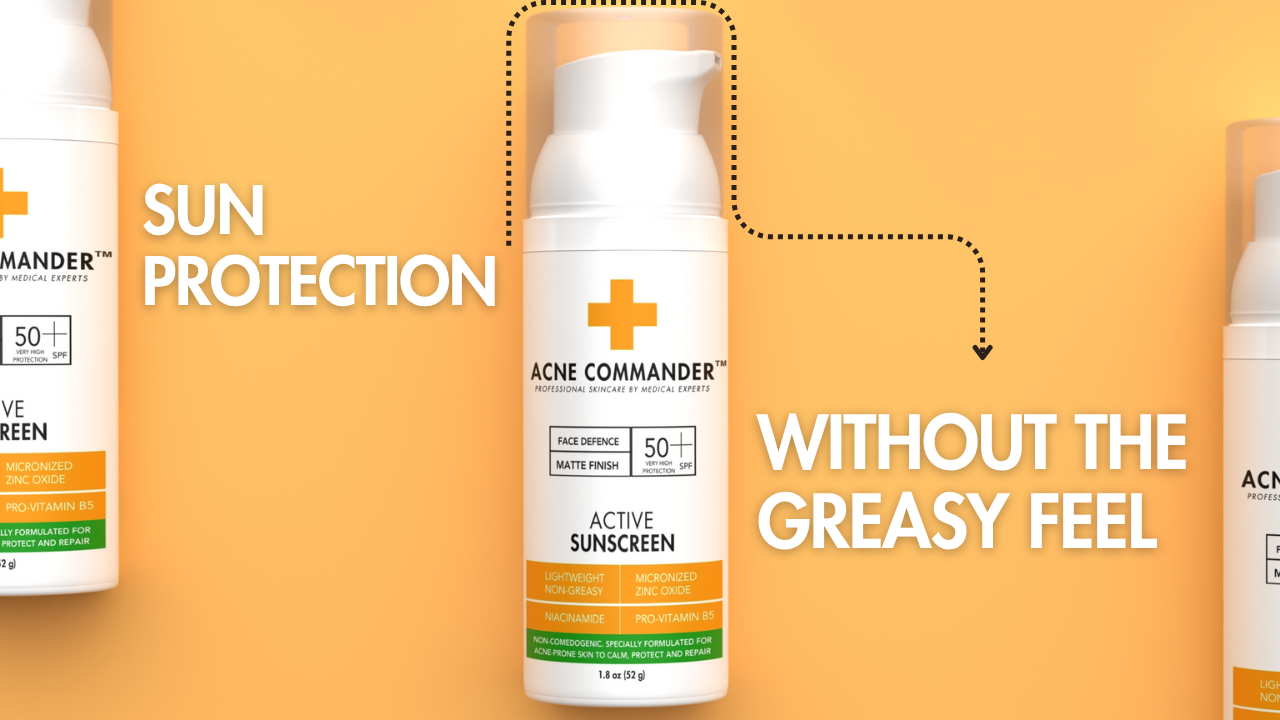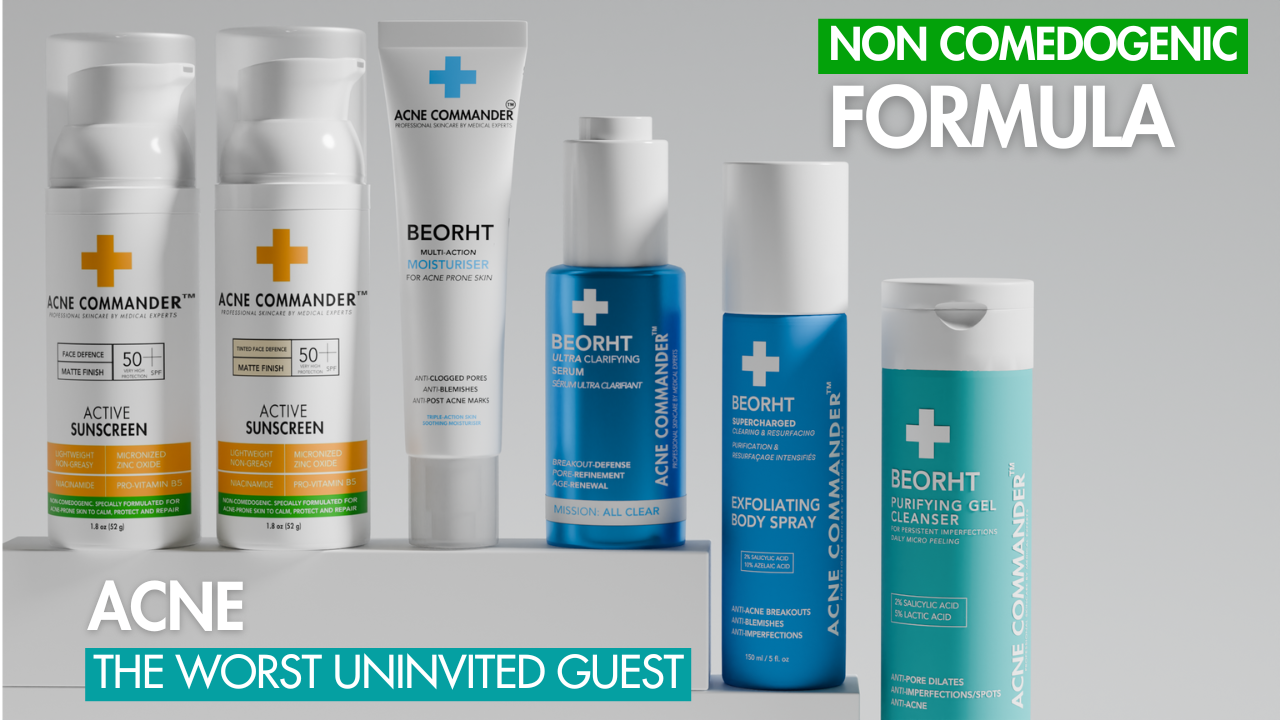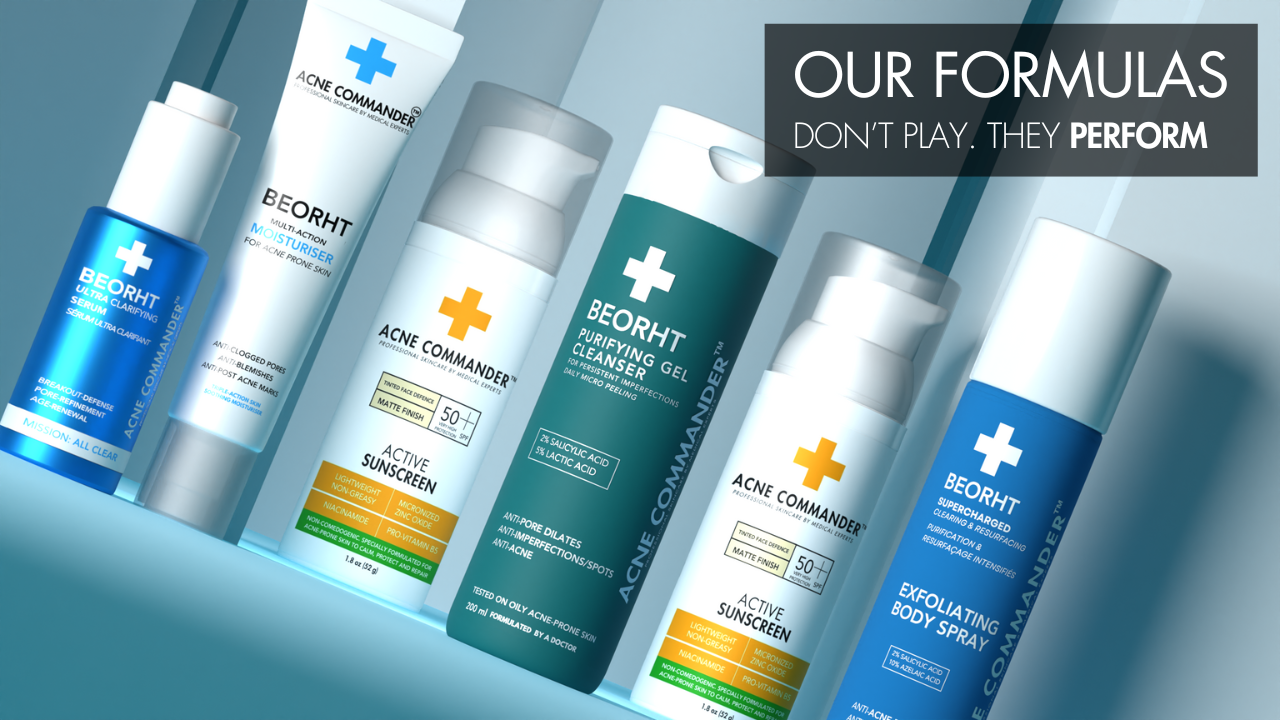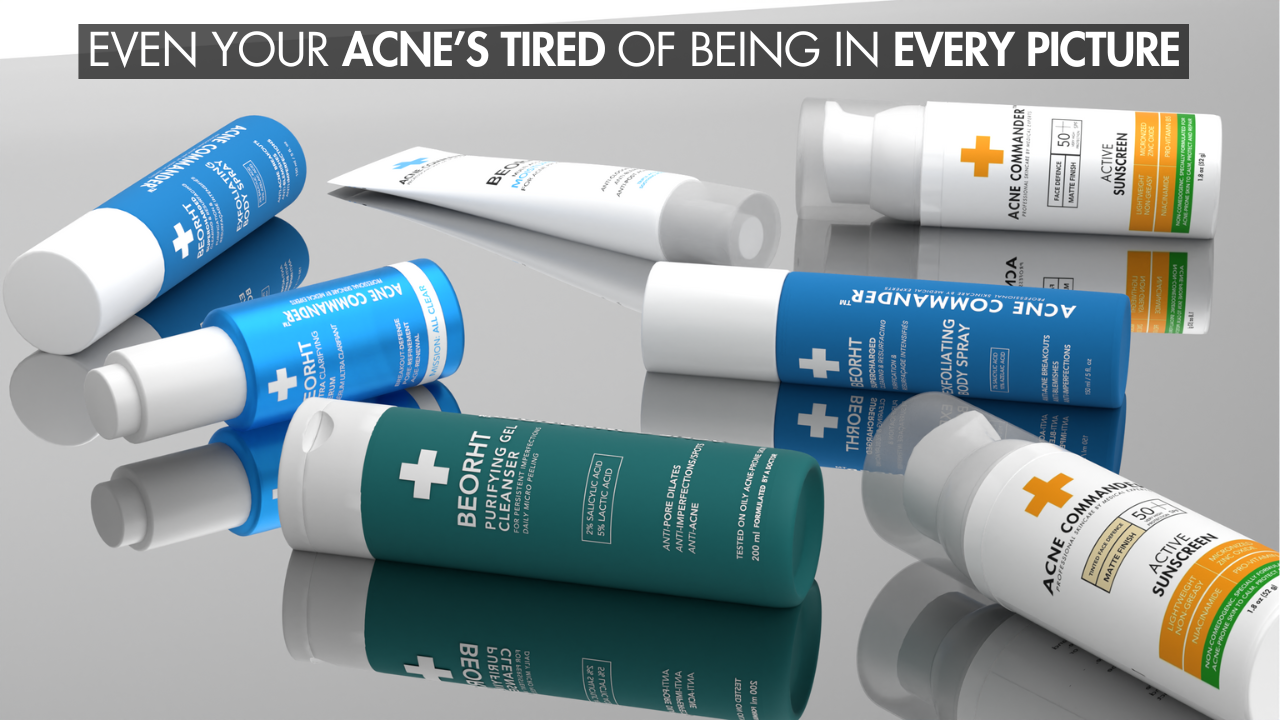Introduction
Facial cleansers are a fundamental part of any skincare routine, particularly for individuals with acne-prone skin. They are designed to remove makeup, dirt, oil, and other impurities that can clog pores and lead to breakouts. However, not all facial cleansers are created equal. Some cleansers, especially those formulated with harsh ingredients or unsuitable for your skin type, can actually contribute to acne rather than help prevent it.
So, can a facial cleanser cause acne? Unfortunately, the answer is yes. While a cleanser should be helping you maintain clear skin, the wrong formula or improper use can make acne worse. In this article, we will explore how facial cleansers can contribute to acne, the ingredients to avoid, and how to choose the right cleanser for your skin. We’ll also discuss why Acne Commander’s Beorht Purifying Gel Cleanser is a fantastic option for acne-prone skin, providing gentle yet effective acne care.
How Can a Facial Cleanser Cause Acne?
A facial cleanser is meant to remove impurities from your skin, but when the wrong product is used, it can actually make acne worse. Here are some of the common ways a cleanser might contribute to acne:
Over-Drying the Skin
Some facial cleansers, especially those designed for oily skin, contain harsh ingredients like sulfates or alcohol that can strip the skin of its natural oils. While this might seem like a good way to control acne, over-drying the skin can actually make acne worse.
When the skin is stripped of moisture, it compensates by producing even more oil to keep the skin hydrated. This excess oil can mix with dead skin cells and clog the pores, leading to acne. Additionally, the lack of moisture can irritate the skin, making it more prone to breakouts and inflammation.
Disrupting the Skin’s Natural Barrier
The skin has a natural moisture barrier that protects it from environmental pollutants, bacteria, and harmful microorganisms. Harsh cleansers can disrupt this barrier, making the skin more vulnerable to irritation and acne-causing bacteria.
When the skin’s natural barrier is compromised, it can lead to inflammation, which often exacerbates acne. Additionally, when the skin is irritated, it may become more sensitive and reactive, making it easier for acne to form.
Clogging Pores
Certain cleansers, especially those that contain heavy oils, silicones, or waxes, can clog the pores and lead to acne. These ingredients can create a layer on the skin that traps oil, dirt, and bacteria in the pores, causing blackheads, whiteheads, and pimples.
If the cleanser you’re using leaves a greasy or heavy residue behind, it may contribute to pore blockages. Even if the cleanser is meant to hydrate or moisturize, if the oils are too thick or comedogenic (pore-clogging), it can trigger acne.
Irritation from Harsh Ingredients
Some facial cleansers contain fragrances, alcohol, or other irritating ingredients that can cause inflammation and redness. For people with acne-prone skin, this irritation can make breakouts worse. Irritated skin becomes more prone to infection, and can lead to more severe acne, especially if the irritation leads to scratching or touching the skin.
Certain exfoliating cleansers, particularly those with rough, abrasive particles, can also irritate the skin and cause microtears, making acne worse by spreading bacteria and exacerbating inflammation.
Using the Wrong Cleanser for Your Skin Type
One of the most common reasons a facial cleanser can cause acne is simply using the wrong cleanser for your skin type. If you have sensitive skin, using a cleanser designed for oily skin can strip your skin and lead to dryness, irritation, and more breakouts. Similarly, using a gentle, hydrating cleanser designed for dry skin on oily, acne-prone skin can leave excess residue, clogging the pores and leading to new acne.
It’s essential to choose a cleanser that matches your skin type and acne concerns. If you have acne-prone skin, look for products formulated to target excess oil and clogged pores without over-drying or irritating the skin.
Explore detailed information for Acne Commander's Beorht Purifying Gel Cleanser. Click Here
The Importance of Choosing the Right Cleanser for Acne-Prone Skin
For those with acne-prone skin, choosing the right cleanser is essential for managing breakouts. A cleanser that is too harsh, too moisturizing, or unsuitable for your skin type can worsen acne. Here are some tips on how to select the best cleanser for acne-prone skin:
1. Non-Comedogenic Formula
When choosing a facial cleanser, look for one that is non-comedogenic, meaning it won’t clog your pores. Pore blockages are one of the primary causes of acne, so using a non-comedogenic cleanser is key to preventing breakouts.
Look for a cleanser that’s specifically designed for acne-prone skin and is labeled non-comedogenic to ensure it won’t contribute to clogged pores and acne formation.
2. Avoid Harsh Chemicals
Harsh chemicals like sulfates, alcohol, and fragrances can irritate the skin and strip it of its natural oils. When your skin is stripped, it can lead to more oil production, dryness, and irritation, all of which contribute to acne. Choose a gentle, sulfate-free cleanser that is free of fragrances and alcohol. Look for a calming formula with ingredients like niacinamide, chamomile, or green tea extract.
3. Acne-Fighting Ingredients
To effectively target acne, your cleanser should contain acne-fighting ingredients like Salicylic Acid, Benzoyl Peroxide, or Tea Tree Oil. These ingredients work to break down excess oil, clear clogged pores, and reduce inflammation, which are all key in managing acne.
-
Salicylic Acid: This BHA works deep within the pores to exfoliate and break down oil, making it ideal for treating blackheads, whiteheads, and pimples.
-
Benzoyl Peroxide: This ingredient kills acne-causing bacteria and is especially effective for inflammatory acne.
-
Tea Tree Oil: This natural oil has antibacterial and anti-inflammatory properties, making it great for soothing acne-prone skin.
4. Hydrating and Soothing Ingredients
Even if you have oily or acne-prone skin, hydration is essential. Dry skin can trigger an overproduction of oil, which leads to more breakouts. Look for a cleanser that contains hydrating ingredients like Hyaluronic Acid, Glycerin, or Aloe Vera. These ingredients help maintain the skin’s moisture balance and keep it hydrated without clogging pores.
Soothing ingredients like niacinamide or calendula extract can help reduce redness and inflammation, making them ideal for acne-prone skin that is prone to irritation.
5. pH-Balanced Formula
The skin’s natural pH is slightly acidic, with a pH of around 4.5 to 5.5. Choose a cleanser that is pH-balanced to avoid disrupting the skin’s natural barrier. A cleanser that is too alkaline can leave the skin dry and irritated, leading to more acne. A pH-balanced cleanser will cleanse effectively without disrupting the skin’s protective layer.
Why Beorht Purifying Gel Cleanser is Ideal for Acne-Prone Skin
Acne Commander’s Beorht Purifying Gel Cleanser is an excellent choice for acne-prone skin due to its gentle yet effective formula. Here’s why it works so well for acne:
-
Salicylic Acid 2%: This BHA penetrates deep into the pores to break down excess oil and dead skin cells, preventing clogged pores and acne.
-
Lactic Acid 5%: Lactic Acid gently exfoliates the surface of the skin, improving texture and fading acne scars over time.
-
Non-Comedogenic Formula: Beorht Purifying Gel Cleanser is designed to be non-comedogenic, meaning it won’t clog pores or contribute to acne formation.
-
Soothing Plant Extracts: Ingredients like Scutellaria Baicalensis Root Extract and Sophora Angustifolia Root Extract help reduce inflammation and soothe irritated skin, which is common with acne.
-
Hydrating Ingredients: Sodium PCA and Butylene Glycol help keep the skin hydrated without clogging the pores.
How to Use a Cleanser for Acne Effectively
To get the best results from your acne cleanser, follow these steps:
Step 1: Wet Your Face with Lukewarm Water
Start by wetting your face with lukewarm water. This helps open the pores, making it easier for the cleanser to penetrate and work effectively.
Step 2: Apply the Cleanser
Take a small amount of your acne cleanser and gently massage it into your face for 30-60 seconds. Focus on areas that tend to be oilier, such as the T-zone (forehead, nose, and chin).
Step 3: Rinse Thoroughly
Rinse your face thoroughly with lukewarm water to remove all traces of the cleanser. Make sure there’s no residue left behind, as any leftover product could clog your pores.
Step 4: Follow Up with Toner and Moisturizer
After cleansing, use a gentle toner to restore the skin’s pH balance. Follow up with a non-comedogenic moisturizer to keep the skin hydrated and prevent dryness.
FAQ
Q1: Can a cleanser cause acne?
Yes, a cleanser can cause acne if it contains harsh ingredients, is too drying, or includes comedogenic oils that clog pores. Always choose a gentle, non-comedogenic formula that is suitable for acne-prone skin.
Q2: What is the best cleanser for acne-prone skin?
The best cleanser for acne-prone skin should contain ingredients like Salicylic Acid, Benzoyl Peroxide, or Niacinamide. Beorht Purifying Gel Cleanser is an excellent option due to its combination of gentle exfoliants and soothing ingredients.
Q3: How often should I use an acne cleanser?
You should cleanse twice a day once in the morning and once at night. Over-cleansing can irritate your skin, so avoid cleansing more than twice daily.
Q4: Does Beorht Purifying Gel Cleanser help with acne scars?
Yes, Lactic Acid in Beorht Purifying Gel Cleanser helps exfoliate the skin, fade acne scars, and improve skin texture over time.
Q5: Can I use an acne cleanser with other acne treatments?
Yes, you can use an acne cleanser alongside other acne treatments. Just be cautious about using too many exfoliating products at once to avoid irritation.
Q6: Is it okay to use an acne cleanser if I have sensitive skin?
Yes, Beorht Purifying Gel Cleanser is formulated to be gentle on sensitive skin while effectively treating acne. It’s ideal for those who have both acne and sensitive skin.
Q7: Can acne cleansers help with acne scars?
Acne cleansers can help improve skin texture and fade acne scars over time. For more targeted scar treatment, you may want to incorporate other products like Vitamin C or Retinol.
Q8: Can I use a foaming cleanser for acne?
Yes, foaming cleansers can work for acne-prone skin, but make sure they are formulated to be gentle and non-drying. Look for one that contains Salicylic Acid or Niacinamide to treat acne.
Q9: What ingredients should I avoid in an acne cleanser?
Avoid cleansers with alcohol, harsh exfoliants, or comedogenic oils. Choose a gentle, acne-targeted cleanser with ingredients like Salicylic Acid, Niacinamide, or Tea Tree Oil.
Q10: Can I use acne cleanser for oily skin?
Yes, acne cleansers are ideal for oily skin. Look for a product that controls oil production while keeping the skin hydrated, like Beorht Purifying Gel Cleanser.
Conclusion
Choosing the right cleanser is essential for managing acne and preventing new breakouts. Acne Commander’s Beorht Purifying Gel Cleanser offers a gentle yet effective solution for acne-prone skin, combining Salicylic Acid, Lactic Acid, and soothing ingredients to keep your skin clear, hydrated, and balanced. By selecting a cleanser that’s tailored to your skin type and acne needs, you can achieve clearer, healthier skin without causing further irritation.
Call to Action:
Ready to take control of your acne? Try Acne Commander’s Beorht Purifying Gel Cleanser today and experience clearer, healthier skin!






